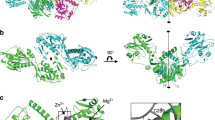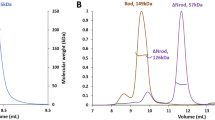Abstract
Dystrophin and β-dystroglycan are components of the dystrophin–glycoprotein complex (DGC), a multimolecular assembly that spans the cell membrane and links the actin cytoskeleton to the extracellular basal lamina. Defects in the dystrophin gene are the cause of Duchenne and Becker muscular dystrophies. The C-terminal region of dystrophin binds the cytoplasmic tail of β-dystroglycan, in part through the interaction of its WW domain with a proline-rich motif in the tail of β-dystroglycan. Here we report the crystal structure of this portion of dystrophin in complex with the proline-rich binding site in β-dystroglycan. The structure shows that the dystrophin WW domain is embedded in an adjacent helical region that contains two EF-hand-like domains. The β-dystroglycan peptide binds a composite surface formed by the WW domain and one of these EF-hands. Additionally, the structure reveals striking similarities in the mechanisms of proline recognition employed by WW domains and SH3 domains.
This is a preview of subscription content, access via your institution
Access options
Subscribe to this journal
Receive 12 print issues and online access
$189.00 per year
only $15.75 per issue
Buy this article
- Purchase on Springer Link
- Instant access to full article PDF
Prices may be subject to local taxes which are calculated during checkout



Similar content being viewed by others
References
Koenig, M., Monaco, A.P. & Kunkel, L.M. Cell 53, 219– 226 (1988).
Straub, V. & Campbell, K.P. Curr. Opin. Neurol. 10, 168–175 (1997).
Tinsley, J.M., Blake, D.J., Zuellig, R.A. & Davies, K.E. Proc. Natl. Acad. Sci. USA 91, 8307– 8313 (1994).
Koenig, M. et al. Am. J. Hum. Genet. 45, 498– 506 (1989).
Roberts, R.G., Bobrow, M. & Bentley, D.R. Proc. Natl. Acad. Sci. USA 89, 2331–2335 (1992).
Jung, D., Yang, B., Meyer, J., Chamberlain, J.S. & Campbell, K.P. J. Biol. Chem. 270, 27305– 27310 (1995).
Rentschler, S. et al. Biol. Chem. 380, 431– 442 (1999).
Sudol, M. Prog. Biophys. Mol. Biol. 65, 113– 132 (1996).
Kay, B.K., Williamson, M.P. & Sudol, M. FASEB J. 14, 231– 241 (2000).
Komuro, A., Saeki, M. & Kato, S. J Biol Chem 274, 36513–36519 (1999).
Chen, H.I. & Sudol, M. Proc. Natl. Acad. Sci. USA 92, 7819–7823 (1995).
Bedford, M.T., Chan, D.C. & Leder, P. EMBO J. 16, 2376– 2383 (1997).
Bedford, M.T., Reed, R. & Leder, P. Proc. Natl. Acad. Sci. USA 95, 10602– 10607 (1998).
Lu, P.J., Zhou, X.Z., Shen, M. & Lu, K.P. Science 283, 1325–1328 (1999).
Ranganathan, R., Lu, K.P., Hunter, T. & Noel, J.P. Cell 89, 875–886 (1997).
Macias, M.J. et al. Nature 382, 646–649 (1996).
Ikura, M. Trends Biochem. Sci. 21, 14–17 (1996).
de Beer, T., Carter, R.E., Lobel-Rice, K.E., Sorkin, A. & Overduin, M. Science 281, 1357–1360 (1998).
Meng, W., Sawasdikosol, S., Burakoff, S.J. & Eck, M.J. Nature 398, 84–90 ( 1999).
Musacchio, A., Saraste, M. & Wilmanns, M. Nature Struct. Biol. 1, 546– 551 (1994).
Prehoda, K.E., Lee, D.J. & Lim, W.A. Cell 97, 471–480 (1999).
Fedorov, A.A., Fedorov, E., Gertler, F. & Almo, S.C. Nature Struct. Biol. 6, 661–665 ( 1999).
Mahoney, N.M., Rozwarski, D.A., Fedorov, E., Fedorov, A.A. & Almo, S.C. Nature Struct. Biol. 6, 666–671 (1999).
Verdecia, M.A., Bowman, M.E., Lu, K.P., Hunter, T. & Noel, J.P. Nature Struct. Biol. 7, 639– 643 (2000).
Yang, B. et al. J. Biol. Chem. 270, 11711– 11714 (1995).
Otwinowski, Z. & Minor, W. Methods Enzymol. 276, 307–326 ( 1997).
Collaborative Computational Project Number4. Acta Crystallogr. D 50, 760–776 (1994).
Tong, L. & Rossman, M.G. J. Appl. Crystallogr. 26, 15–21 (1993).
Otwinowski, Z. in Isomorphous replacement and anomalous scattering, Proc. Daresbury Study Weekend, 80–85 (SERC Daresbury Laboratory, Warrington, UK; 1991)
Jones, T.A. & Kjeldgaard, M. Methods Enzymol. 277, 173–208 (1997).
Brunger, A. X-PLOR Version 3.0: a system for crystallography and NMR. (Yale University Press, New Haven; 1992).
Lamzin, V.S. & Wilson, K.S. Methods Enzymol. 277 , 269–305 (1997).
Nguyen, J.T., Turck, C.W., Cohen, F.E., Zuckermann, R.N. & Lim, W.A. Science 282, 2088– 2092 (1998).
Acknowledgements
The authors thank C. Dahl for synthesis and purification of the β-dystroglycan peptide and A. Farooq for help with microcalorimetry measurements. We thank M. Macias for coordinates of the Yap WW domain and for helpful discussions in comparing the structures. This work was supported in part by grants from the NIH (to M.S.), the Muscular Dystrophy Association (to M.J.E. and M.S.), and by the US Department of Energy, Office of Biological and Environmental Research (to A.J. and Rg.Z). M.J.E. is a recipient of a Burroughs-Wellcome Career award in the Biomedical Sciences, and a member of the Harvard-Armenise Center for Structural Biology. Diffraction data were recorded at the Advanced Photon Source at Argonne National Labs, and at CHESS, which is supported by grants from the NIH and NSF.
Author information
Authors and Affiliations
Corresponding author
Rights and permissions
About this article
Cite this article
Huang, X., Poy, F., Zhang, R. et al. Structure of a WW domain containing fragment of dystrophin in complex with β-dystroglycan. Nat Struct Mol Biol 7, 634–638 (2000). https://doi.org/10.1038/77923
Received:
Accepted:
Issue Date:
DOI: https://doi.org/10.1038/77923
This article is cited by
-
Involvement of abnormal dystroglycan expression and matriglycan levels in cancer pathogenesis
Cancer Cell International (2022)
-
NEDD4 regulates ubiquitination and stability of the cell adhesion molecule IGPR-1 via lysosomal pathway
Journal of Biomedical Science (2021)
-
Duchenne muscular dystrophy
Nature Reviews Disease Primers (2021)
-
SMURF1, a promoter of tumor cell progression?
Cancer Gene Therapy (2021)
-
Profiling of the muscle-specific dystroglycan interactome reveals the role of Hippo signaling in muscular dystrophy and age-dependent muscle atrophy
BMC Medicine (2020)



